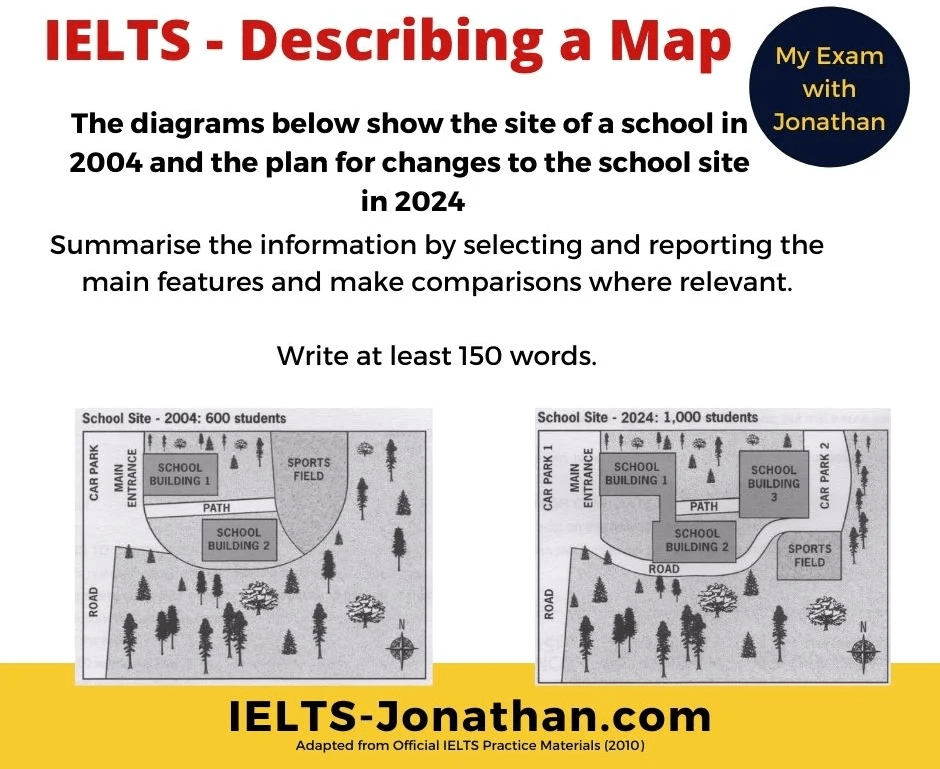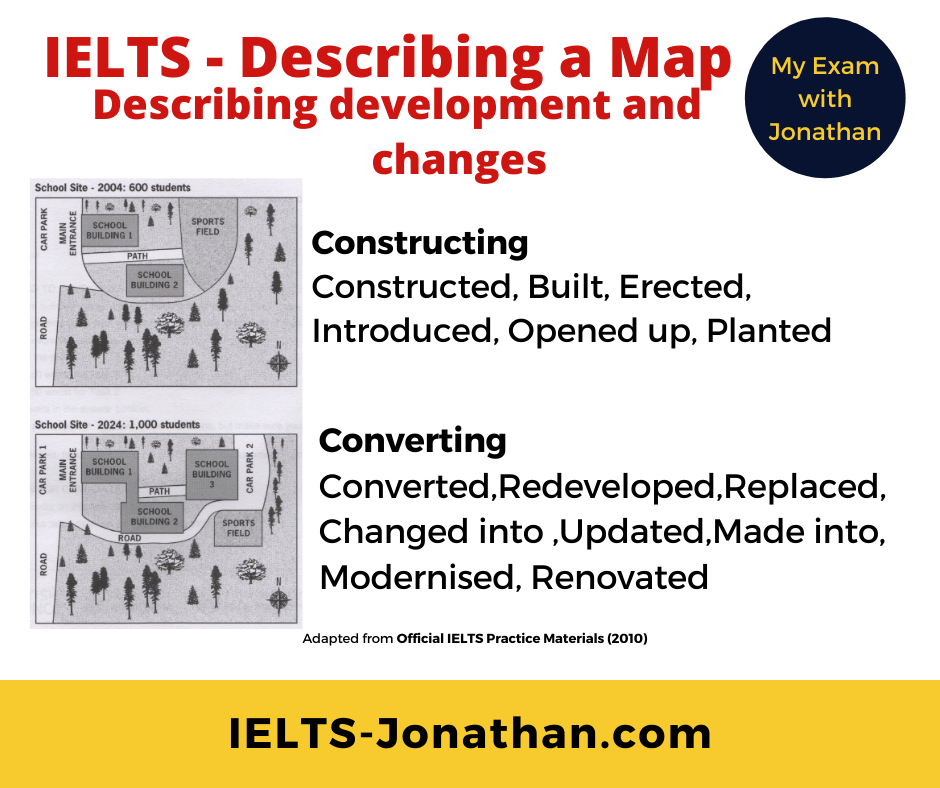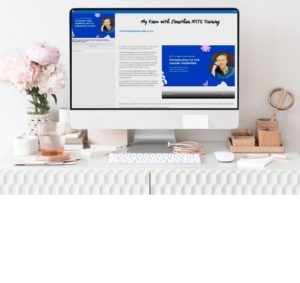Using language and vocabulary for IELTS maps, plans and diagrams
In order to describe a map well there are three key aspects of language to be considered. These are vocabulary, prepositions and choice of grammar.
1) Key Vocabulary for describing Maps
Vocabulary to describe changes and developments is mostly generic and most often used in the passive.
The questions in this post are adapted from
The Cambridge Official Guide to IELTS and IELTS Official Practice Materials Book 2
but the information can be applied to almost any IELTS map or plan question.
The diagrams below show the site of a school in 2004 and the plan for changes to the school site in 2024
Summarise the information by selecting and reporting the main features and make comparisons where relevant.
Write at least 150 words.
The format of these types of question are very visual and therefore seems easier to answer than other formats, and because they are less common, students often prepare less for it.
This is a mistake as it is really important to be prepared for all types of IELTS questions. But, the good news is that the preparation won’t take as long as you might think.
There are different types of maps and the most common you will see is the past and present or near present comparison.
Use the dates on the maps to determine the correct tense.
A number of buildings were demolished. The surrounding area was then enlarged and redeveloped into three small retail parks and four green areas.
A number of buildings have been demolished.
A number of buildings will be demolished.
Sometimes there is no date, just ‘before‘ and ‘after‘
Be aware that in order to describe developments and changes the passive tense is preferred choice;
- The shopping centre was extended, and the parking area was enlarged to allow for more parking and a bus stop.
- The derelict building was torn down and removed and a new modern student building was constructed in its place.
- The children’s play area was reconstructed nearer to the entrance of the park and a wildlife habitat was put in its place.
- A number of trees were removed to allow for the construction of the new footpath.
- An extension to the bus line was planned with the installation of three new bus stops.
- Most of the farm buildings were updated and enlarged with solar PV panels providing free power.
- The college reception was updated, and an additional seating area was provided for visitors.
- The town centre was closed to traffic to allow for a new pedestrian area.
2) Vocabulary which shows location
Generic Phrases
If a compass is provided with the map the location can be described using generic phrases such as
- to the north of
- to the west of
- to the east of
- north of
- south east of
and
- in the north, in the south, in the southeast etc…
If a scale is given on the map, you can use measurements to describe location
- Three miles north of
- One mile south of
Prepositions
Prepositions are used to give exact locations on a map, such as:
- along
- across from
- beside
- between
- from north to west
- from east to west
- from / to
- in between
- nearby
- near to
- next to
- not far from
- opposite
- over
Example sentences using a scale and compass:
- The hedge and trees to the south of the river were cut down and a new student building was built.
- A small hydro-electric dam was constructed on the river to the south of the city.
- The overflow carpark to the north of the university was removed and a new student residential complex was constructed in its place.
- The business park to the north west of the metro station was enlarged and new parking facilities were provided.
- A new bus stop was installed three miles east of the bus station
- A new 4 mile stretch of road was built connecting the houses to the freeway.
Using Prepositions:
- Recycling bins were positioned next to the college faculty.
- New student housing and flats were constructed opposite the public park.
- The small river near the road was diverted away to the east.
- A new light railway running from east to south was built.
- A public footbridge from the residential area to the school was built.
- Electric charging facilities for EV vehicles were added in the retail area.
- The education quarter across from the park was extended to the south and new leisure facilities were also built.
IELTS Writing Task 1 Structure
Question adapted from IELTS Official Practice Materials Book 2
Grammar and vocabulary for describing developments and change
There are generally three tenses commonly used with maps and plans.
- The present perfect tense
- The past tense
- and the future tense for future plans and predictions
- as well as the present tense
These are often used as passive constructions as in this example.
- The small wood near the river was cut down.
When we describe change, the present perfect and the present perfect passive can often be used.
- The small wood near the river has been cut down.
The past simple passive can also be used to suggest something was completed in the past.
- The small wood near the river was cut down.
Here, there is a prediction, so ‘going to’ passive is used.
- The small wood near the river is going to be cut down.
Time phrases are often used such as:
- over the 30-year period
- between 1908 and 1928
- from 1980 to 2000
- over the years
- in the last 30 years
- in the years after 1980
The present perfect and present perfect passive often show that something started in the past and was completed up until the present moment.
Note: The Past Perfect is not used when describing maps in IELTS.
Examples:
- The town has seen many significant changes.
- The east of the town has become more industrialised.
- A swimming pool has been built.
- A basketball court has been added
- The football ground has been modernised.
These sentences below are often used to give an overview of the main differences between two maps.
- Over the 30-year period the area has seen significant changes especially to the rural areas which have been redeveloped. (Present perfect x 2)
- Between 1908 and 1928 the old manufacturing was replaced by urban and retail areas. (Past simple passive)
- From 1980 to 2010 a new housing estate was constructed where a school once stood. (Past simple passive + past simple)
- The number of wooded and green spaces have changed over the two decades and have mostly been replaced by residential. buildings. (Present perfect and passive)
- In the period from 1990 onward, the leisure facilities were completely renovated. (Past simple passive)
- The city centre has seen dramatic changes over the years. (Present perfect)
- In the years after 1990 the city centre was extensively modernised. (Past simple passive)
Further examples
- The town used to be heavily industrialised, but it has become more residential in the last two decades.
- The town used to have many green spaces, but it has become urbanised in the last 20 years.
- The outskirts of the town used to be rural but have now become urban areas.
- A new stadium has been built and more sports facilities have been opened over the years.
What grammar and vocabulary example can you take and learn from this question response?
The two maps show the layout changes of a school over a 20-year time period to accommodate an increase in student numbers. In order to do this, it is clear that there will be both additional buildings and parking spaces while there will be a reduction in outdoor sports facilities and green or wooded areas.
In 2004, access to the school was by road in the south-east. The original layout consisted of a single car park located near the main entrance to the school and two school buildings separated by a path. The path connected the car parking area with the sports field while the remaining area was made up of wooded and green areas.
In is anticipated that by 2024 the sports field will have moved south to accommodate the construction of an additional school building and reorganisation of the general school layout. Buildings 1 and 2 will be connected by a corridor and the original path no longer leads from the main entrance to the sports field but is shortened to connect building 3 with the main school A new road will be built behind building 2 connecting the main entrance to a new car park. This construction means that the wooded area and sports field in the north will be reduced.
214 words
Comment for a reply and Good Luck with your exam preparation.
Jonathan
The Best Approach to Task 2 Writing
Paragraphing in Task 2 Writing
Writing – Benefits of a Foreign University Education
I’m Jonathan
I’ve taught IELTS and University English in more than a dozen universities and schools around the world.
I’m a parent, traveller and passionate about language teaching and helping students achieve their dreams.
Whilst living in Austria or working in Asia, I run IELTS courses to help students get to where they want to be.
If you are serious about IELTS, connect with me to see how I can help you.






Was this helpful? Leave a comment :)